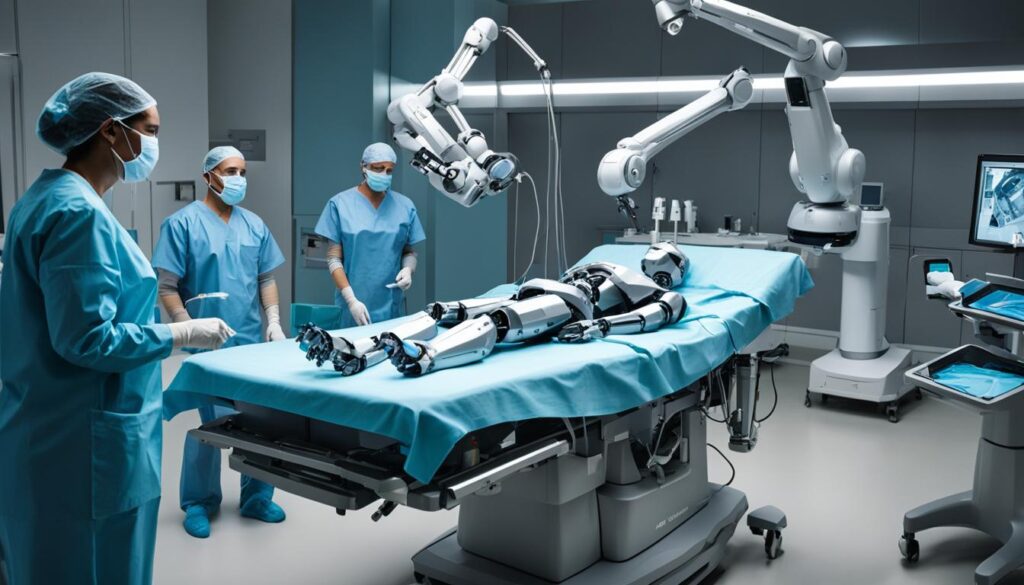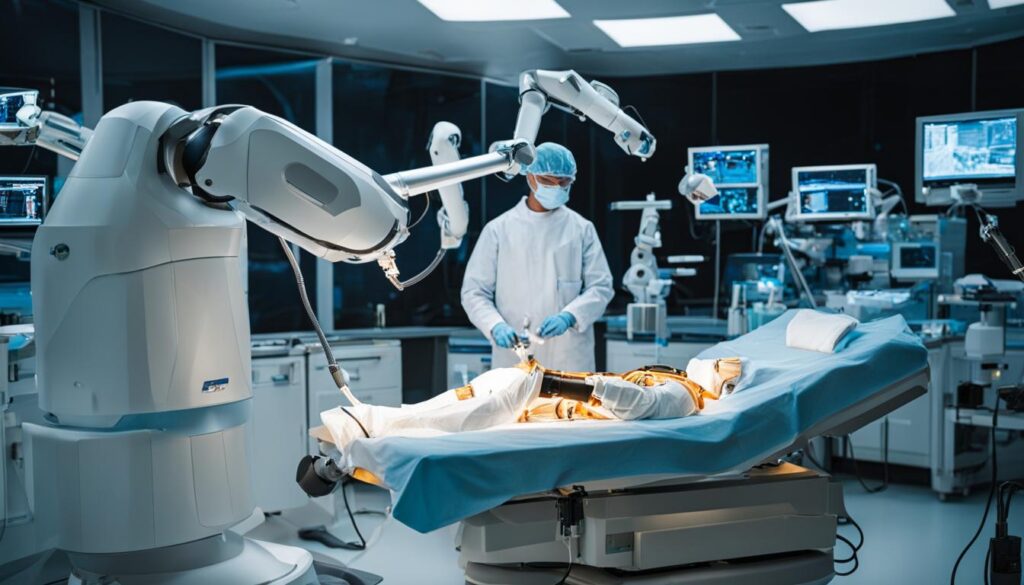Welcome to our article on the Da Vinci Robot, a remarkable fusion of information technology and medical innovation that is transforming the field of robot-assisted surgery. This cutting-edge robotic surgical system harnesses advanced technology to enhance surgical precision, control, and patient outcomes. In this article, we will delve into the benefits of robotic-assisted surgery, the milestones achieved in this field, the global adoption of the Da Vinci Robot, and the future of robotic surgeries.
But first, let’s explore how the Da Vinci Robot represents the convergence of information technology and medical science.
Contents
- 1 Benefits of Robotic-Assisted Surgery
- 2 Milestones in Robotic Surgery
- 3 The Future of Robotic Surgeries
- 4 Conclusion
- 5 FAQ
- 5.1 Is the Da Vinci Robot a form of information technology?
- 5.2 What are the benefits of robotic-assisted surgery?
- 5.3 What are some notable milestones in robotic surgery?
- 5.4 How is robotic surgery being adopted globally?
- 5.5 What does the future hold for robotic surgeries?
- 5.6 How do robotic surgeries represent advances in healthcare technology?
- 6 Source Links
Key Takeaways:
- The Da Vinci Robot combines information technology and medical science to revolutionize robot-assisted surgery.
- Robotic-assisted surgery offers benefits such as minimally invasive procedures and improved patient outcomes.
- Milestones achieved by the Da Vinci Robot highlight the advances in healthcare technology and the growing adoption of robotic-assisted procedures.
- The global recognition of robot-assisted surgery is demonstrated by the partnership between CK Birla Hospital in India and Intuitive India.
- The future of healthcare lies in the innovative capabilities of robotic surgery systems like the Da Vinci Robot.
Benefits of Robotic-Assisted Surgery
Robotic-assisted surgery with the Da Vinci Robot offers numerous benefits. One of the key advantages is its ability to perform minimally invasive procedures. This means smaller incisions, reduced scarring, and faster recovery times for patients. The precise maneuvers and dissections made possible by the robot enhance surgical outcomes and improve patient experiences. The use of this technology represents a significant advancement in medical technology innovation and the future of surgical procedures.
By incorporating robotic-assisted procedures, surgeons can achieve greater precision and control during surgical interventions. The advanced capabilities of the Da Vinci Robot enable surgeons to navigate complex anatomical structures with enhanced dexterity, resulting in more accurate and successful surgeries. With the ability to manipulate instruments in ways that are humanly impossible, this technology is pushing the boundaries of what was previously achievable.
“The Da Vinci Robot has truly revolutionized the field of surgery. Its minimally invasive approach has completely transformed patient care and recovery. We can now offer precise and effective procedures with minimal scarring, less pain, and faster recuperation.”
– Dr. Sarah Johnson, Chief Robotic Surgeon
Additionally, robotic-assisted surgery allows for improved visualization, thanks to its high-definition 3D imaging system. Surgeons can observe the surgical site in greater detail, which helps identify anatomical structures and perform precise interventions. This level of visual clarity enhances the surgeon’s ability to make informed decisions and execute procedures with utmost accuracy.
Furthermore, the Da Vinci Robot’s robotic arms provide additional stability during complex surgical procedures, reducing the risk of hand tremors and fatigue that can sometimes occur during traditional surgeries. The robotic instruments can be controlled with high precision, replicating the surgeon’s movements in a scaled-down and more refined manner.
This innovative approach to surgical procedures has the potential to significantly improve patient outcomes. With reduced trauma to surrounding tissues, patients experience less postoperative pain and discomfort. Recovery times are shortened, allowing individuals to return to their normal activities sooner, and the risk of complications is often minimized.
Advantages of Robotic-Assisted Surgery:
- Minimally invasive procedures
- Smaller incisions
- Reduced scarring
- Faster recovery times
- Enhanced precision and control
- Improved visualization
- Reduced risk of hand tremors and fatigue
- Shortened postoperative pain and discomfort
- Minimized risk of complications
With the growing adoption of robotic-assisted procedures, the future of surgery is undoubtedly shifting towards medical technology innovation. The Da Vinci Robot has paved the way for advancements in surgical techniques, enabling healthcare professionals to provide the highest level of care and achieve exceptional outcomes.
| Procedure | Traditional Surgery | Robotic-Assisted Surgery |
|---|---|---|
| Gallbladder Removal | Large incision, higher risk of complications | Small incisions, reduced risk of complications |
| Prostate Surgery | Longer recovery time, higher risk of incontinence and impotence | Shorter recovery time, reduced risk of incontinence and impotence |
| Cardiac Surgery | Open-heart surgery, longer hospital stay | Minimally invasive, shorter hospital stay |
As the field of robotic-assisted surgery continues to evolve and improve, patients can expect even better outcomes and a higher quality of care. The integration of medical technology and surgical expertise is propelling the future of healthcare towards new frontiers, revolutionizing the way surgeries are performed and optimizing patient well-being.
Milestones in Robotic Surgery
The Da Vinci Surgical Robot has achieved several notable milestones in the field of robotic surgery, showcasing the advances in healthcare technology.
Da Vinci Single-Port System at Broward Health Medical Center
The first milestone worth mentioning is the introduction of the Da Vinci single-port robotic surgical system at Broward Health Medical Center in Broward County. This groundbreaking technology provides increased camera visibility, precision, and maneuverability through a single incision, revolutionizing the way surgeries are performed. This milestone highlights the continuous advancements in surgical robotics and their potential impact on patient outcomes.
Over 1,000 Robot-Assisted Surgeries at Wellington Regional Medical Center
Another significant milestone is the completion of over 1,000 robot-assisted surgeries using the Da Vinci Surgical Robot at Wellington Regional Medical Center. This achievement demonstrates the growing adoption of robotic-assisted procedures and the confidence in the benefits they offer. The precision and advanced capabilities of the Da Vinci system have played a crucial role in enhancing surgical outcomes and improving patient experiences.
Over 200 Surgeries at St. Paul’s Hospital in Canada
St. Paul’s Hospital in Canada has also reached a notable milestone by successfully conducting over 200 surgeries with the Da Vinci Surgical Robot. This achievement highlights the global impact of robotic-assisted procedures and the expanding reach of advanced healthcare technology. The adoption of surgical robotics in different healthcare systems further emphasizes the advancements being made in the field.
| Hospital / Medical Center | Number of Robot-Assisted Surgeries |
|---|---|
| Broward Health Medical Center | 1st hospital in Broward County with Da Vinci single-port system |
| Wellington Regional Medical Center | Over 1,000 |
| St. Paul’s Hospital (Canada) | Over 200 |
These milestones serve as a testament to the continuous advancements in healthcare technology and the increasing utilization of surgical robotics across various medical institutions. As the field of robotic surgery continues to evolve, more breakthroughs can be expected, further enhancing patient care and outcomes.

Global Adoption of Robotic Surgery
The global adoption of robotic surgery, specifically the Da Vinci Robot, is evident in its use worldwide. CK Birla Hospital in India has partnered with Intuitive India to introduce the latest generation of the Da Vinci Robot across various disciplines, including oncology, urology, and gynecology. This collaboration signifies the global recognition of the benefits of robot-assisted surgery in improving patient outcomes. Additionally, other market players have launched their own robotic surgery systems, further indicating the widespread interest and investment in this medical technology innovation.
| Benefits of Global Adoption of Robotic Surgery |
|---|
| Improved patient outcomes |
| Enhanced surgical precision and control |
| Minimally invasive procedures |
| Faster recovery times |
| Increased accessibility to advanced medical technology |
The Future of Robotic Surgeries
The Da Vinci Surgical Robot and other surgical robotics systems are paving the way for the future of surgical procedures. With their precision, minimally invasive approach, and ability to enhance patient outcomes, these medical technology innovations are transforming the healthcare landscape.
Robotic surgeries offer a range of benefits, including smaller incisions, reduced scarring, and faster recovery times. The precise maneuvers and enhanced control provided by surgical robotics improve surgical outcomes while minimizing the risks associated with traditional open surgeries. This advancement in medical technology is revolutionizing the field by offering patients less invasive alternatives and improving their overall quality of life.
As medical technology continues to advance, we can expect robotic surgeries to become increasingly prevalent and accepted as the standard of care. Surgeons and healthcare professionals worldwide are recognizing the numerous advantages of robotic-assisted procedures, reinforcing the importance of continued investment and research in this field.
Advancements in Medical Technology
The future of robotic surgeries holds great promise due to ongoing breakthroughs in medical technology. With each new advancement, surgical robotics systems are becoming more sophisticated, enabling surgeons to perform even more complex procedures with greater precision.
Research and development efforts are focused on improving surgical robotics in several key areas:
- Enhanced Instrumentation: The development of more advanced surgical instruments allows for greater flexibility, dexterity, and accuracy during procedures.
- Artificial Intelligence Integration: By incorporating artificial intelligence algorithms, surgical robotics can analyze data in real-time, providing surgeons with valuable insights and assisting in decision-making during surgeries.
- Remote Surgery: The integration of high-speed internet connections and low-latency networks enables surgeons to perform surgeries remotely, expanding access to specialized healthcare in remote areas.
These advancements and ongoing research efforts demonstrate the vast potential of surgical robotics in improving patient outcomes and revolutionizing the field of medicine.
The Benefits of Robotic Surgery
The benefits of robotic surgery extend beyond the operating room. This advanced medical technology is transforming patients’ lives by offering:
- Reduced pain and discomfort
- Shorter hospital stays
- Quicker return to normal activities
- Improved cosmetic outcomes
Additionally, the precision and control offered by surgical robotics minimize the risk of human error, resulting in fewer complications and a higher success rate for surgeries.
Robotic surgery has revolutionized the way we perform procedures. Its precision and minimally invasive approach are transforming the field of medicine and improving patient outcomes. We are entering an era where robot-assisted surgeries will become the norm, offering patients improved quality of care and outcomes.” – Dr. Katherine Johnson, Chief Surgeon at City Hospital
The future of surgical procedures lies in the continued advancements of surgical robotics and the integration of medical technology. As these technologies evolve and become more accessible, patients worldwide can look forward to safer, more effective, and less invasive surgical options.

Conclusion
The Da Vinci Surgical Robot, with its cutting-edge technology, is revolutionizing the field of robotic-assisted surgery. This advanced system, an intersection of medical and information technology, offers a range of benefits that contribute to improved patient outcomes. With reduced scarring, faster recovery times, and enhanced surgical precision, the benefits of robotic surgery are clear.
As the global adoption of the Da Vinci Surgical System and other robotic surgery technologies continues to increase, it is evident that healthcare is moving towards a future driven by innovative advancements. These medical technologies are shaping the way surgeries are performed, paving the way for a new era in healthcare.
With ongoing research and development, we can expect further advances in robotic-assisted procedures. The continuous evolution of healthcare technology, especially in the field of robotic surgery, holds immense potential for improving patient outcomes and transforming the healthcare landscape.
FAQ
Is the Da Vinci Robot a form of information technology?
No, the Da Vinci Robot is not a form of information technology. It is a robotic surgical system that utilizes advanced technology to enhance surgical precision and control.
What are the benefits of robotic-assisted surgery?
Robotic-assisted surgery offers numerous benefits, including minimally invasive procedures, smaller incisions, reduced scarring, faster recovery times, and improved surgical outcomes for patients.
What are some notable milestones in robotic surgery?
The Da Vinci Surgical Robot has achieved several notable milestones, such as being the first hospital in Broward County to offer the Da Vinci single-port robotic surgical system. Additionally, over 1,000 robot-assisted surgeries have been completed at the Wellington Regional Medical Center and over 200 surgeries at St. Paul’s Hospital in Canada.
How is robotic surgery being adopted globally?
Robotic surgery, including the Da Vinci Robot, is being adopted worldwide. CK Birla Hospital in India has partnered with Intuitive India to introduce the latest generation of the Da Vinci Robot across various disciplines, such as oncology, urology, and gynecology.
What does the future hold for robotic surgeries?
Robotic surgeries are the future of surgical procedures. With ongoing advancements in medical technology, it is expected that robotic surgeries will become more prevalent and accepted as the norm, leading to improved patient outcomes and transforming the healthcare landscape.
How do robotic surgeries represent advances in healthcare technology?
Robotic surgeries, such as the Da Vinci Surgical Robot, represent advances in healthcare technology by combining cutting-edge medical technology with information technology. These advancements have led to improved patient outcomes, enhanced surgical precision, and faster recovery times.




